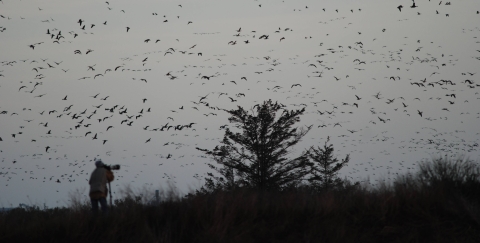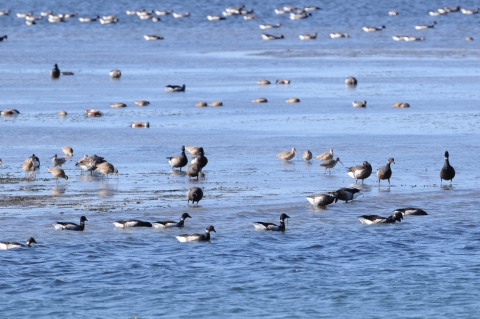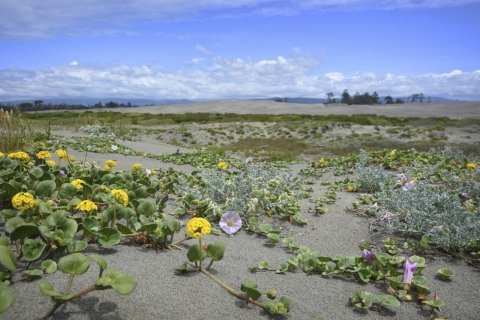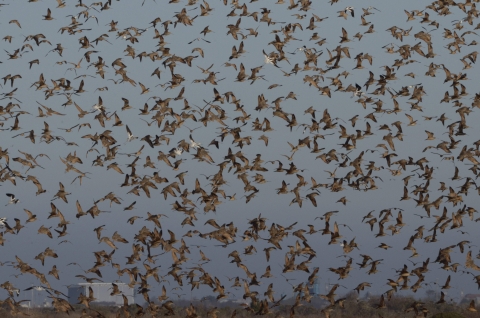About Us
“Tens of thousands of geese blackened the sky during seasonal migrations, their rhythmic honking punctuating the long V-shaped formations that swirled onto the marshes. So many foods to sustain the people: salmon, surf fish, clams, mud hens, elk and deer, acorns, Indian potatoes, huckleberries, hazel nuts and more, enough to host many tribes at the annual World Renewal Dances and to preserve and set aside for the lean winter months. Wiyot people lived in balance with this bounty, never taking more than needed and tending to the needs of the plants and animals. They wintered over in villages of split redwood plank houses built along the shores of Wigi (Humboldt Bay)…” excerpted from a piece by Lynnika Butler at https://www.wiyot.us
Refuge History
The Humboldt Bay National Wildlife Refuge Complex, which includes Castle Rock National Wildlife Refuge, was established in 1971, to conserve precious habitat for the great diversity of birds, mammals, fish, amphibians, invertebrates, and plants that occur along the Pacific Coast of northern California.
The refuge has several different units totaling almost 5,000 acres. These units consist of a mosaic of mudflats, estuarine eelgrass meadows, saltmarsh, brackish marsh, seasonally flooded freshwater wetlands, riparian riparian
Definition of riparian habitat or riparian areas.
Learn more about riparian wetlands, streams, coastal dunes, and forest, creating a unique complexity and interconnected landscape. These habitats support more than 450 species of plants, over 316 species of birds, and 40 species of mammals. The majority of birds use the refuge as a stopover where they rest and replenish energy reserves. Others spend winter here, and some use the refuge for breeding and nesting. The wetlands around Humboldt Bay are critical to over half a million shorebirds during spring migration and have been designated a Western Hemisphere Shorebird Reserve Network Site of Hemispheric Importance.
More than 50% of the Pacific brant goose (Black Brant) population refuels on the eelgrass meadows growing in the shallow parts of Humboldt Bay. The refuge also provides habitat for approximately 100 species of fish and marine invertebrates, many of which contribute to sport and commercial fisheries, including steelhead, coho and chinook salmon, and Dungeness crab.
The Lanphere and Ma-le’l Dunes Units of the refuge have been designated a National Natural Landmark National Natural Landmark
The National Natural Landmarks Program preserves sites illustrating the geological and ecological character of the United States. The program aims to enhance the scientific and educational value of the preserved sites, strengthen public appreciation of natural history and foster a greater concern for the conservation of the nation’s natural heritage. The program was established in 1962 by administrative action under the authority of the Historic Sites Act of 1935. The first National Natural Landmarks were designated in 1963. Today, there are more than 600 National Natural Landmarks in 48 states, American Samoa, Guam, Puerto Rico and the U.S. Virgin Islands.
Learn more about National Natural Landmark as they represent one of the most diverse and highest quality remnants of coastal dunes habitat in the Northern Pacific Border Biophysiographic Region.
Cultural History and Resources
The southern Humboldt Bay units of the refuge were previously a vast extension of saltmarsh and home of the Wiyot people. After the arrival of the European-American pioneers in the late 1800s, the land was dredged and rapidly converted into agricultural lands, destroying over 90% of the original saltmarsh. In 1971, the first portions of salt marsh salt marsh
Salt marshes are found in tidal areas near the coast, where freshwater mixes with saltwater.
Learn more about salt marsh and mudflat were acquired to protect coastal habitats for wildlife. In 1988, more land was acquired, creating the southern Humboldt Bay units.
Today, Humboldt Bay National Wildlife Refuge manages about 5,000 acres including the bay area, Ma-le’l and Lanphere Dunes. Despite the historical disturbance in Humboldt Bay National Wildlife Refuge, years of hard work and dedication have restored and created new types of habitats for wildlife, making this land functional for a wide variety of species.
The Wiyot tribe
First Native American occupation in the northwest California records from at least 8,000 years ago, that is subdivided into three time periods, the Borax Lake Pattern, the Willits Pattern, and the Gunther Pattern. There are approximately 45 formally recorded cultural resource sites in the Humboldt Bay NWR. An exact count is impossible to ascertain at this time because many of the recorded sites have not been field checked since the creation of the refuge so their location with respect to the boundary of the refuge is not well understood. Furthermore, only a small fraction of the refuge has been specifically inspected for cultural resources.
Our Mission
The mission of the National Wildlife Refuge System is to administer a national network of lands and waters for the conservation, management and, where appropriate, restoration of the fish, wildlife and plant resources and their habitats within the United States for the benefit of present and future generations of Americans.
Other Facilities in this Complex
Castle Rock National Wildlife Refuge is located eighty miles north of Humboldt Bay and about a half mile offshore from Crescent City, California. Castle Rock is only 14 acres in size, but is critical to the survival of several hundred thousand seabirds each year and also serves as an important haul out (resting site) for marine mammals, including harbor seals, northern elephant seals and California and Steller sea lions.







